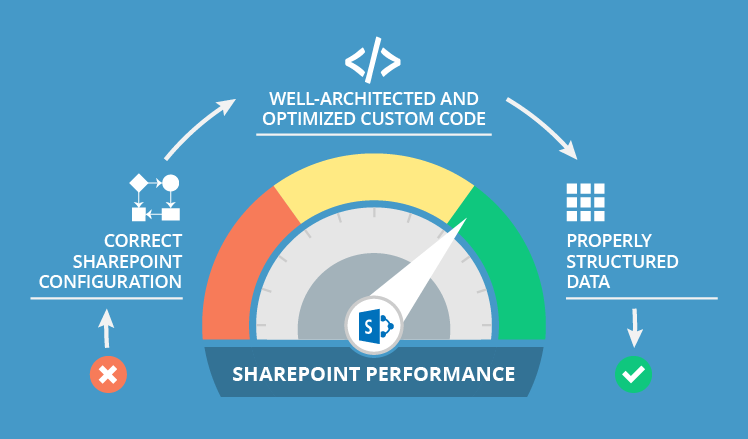On the way to better SharePoint performance
When SharePoint functions at its full capacity, the volume of stored data grows very fast. Yes, it’s a positive trend that proves users like the portal. But the reverse side is that your SharePoint evolution is often accompanied by SharePoint performance problems such as slow-downs and bad user experience.
A purely technical issue, a poor SharePoint performance is actually just the tip of the iceberg, as it hides more serious troubles such as users’ low productivity and buy-in. Slowly loading pages is the most annoying trouble that is able to weaken the portal’s reputation and become a serious source of users’ irritation. So to help your portal restore its slick functionality there are a few questions for you to answer.

Is your SharePoint configured well?
When facing a poor SharePoint performance, users tend to blame the platform itself. Still the improper configuration of SharePoint sites is the number-one reason of bad performance that we have seen in our SharePoint consulting practice since 2007. Here are some possible configuration issues that can affect your SharePoint site:
- Incorrect planning and sizing of a SharePoint farm. Your farm is the skeleton that makes the entire SharePoint site move. When the farm doesn’t match your business needs, performance problems won’t keep you waiting. It’s worth analyzing if there are enough servers in the farm and if they are not overloaded. The farm should grow in line with the company’s development, so there is no use blaming the SharePoint hosted on an SQL server and a front-end one that stutter at 1,000+ concurrent users. A timely sizing of a SharePoint farm is the key to your site’s vitality.
- Unnecessary usage of Business Connectivity Services (BCS). With BCS you can easily connect external data to your SharePoint site and use it as the site’s native data. However, it’s worth mentioning that BCS are pretty slow when dealing with large datasets. Thus, to help your SharePoint site, it’s highly preferable to control the amount of external data and BCS in order to avoid performance troubles.
- Incorrectly configured Distributed Cache Services. When your SharePoint site handles big volumes of data or contains a whole range of applications, it’s advisable to deploy Distributed Cache in the dedicated mode or to move it to a separate server, which will help to increase your site performance significantly.
Does your custom code run correctly?
Once developed, a SharePoint site can go through multiple transformations in order to comply with business and user requirements. Very often companies rely on their in-house developers to enrich the site with a fresher functionality. Unfortunately, when developed with no deep understanding of SharePoint specificity, home-made custom apps can cause a lot of troubles if they contain mistakes or don’t fit in your SharePoint site.
- Non-optimized Application Custom Code can trigger a poor SharePoint performance. While assessing a custom code it’s important to identify the pieces that cause performance issues in the SharePoint infrastructure. Among the most popular code errors there are huge numbers of try-catch statements, logging executions, not optimized functionality inside the delegate control, logical errors, usage of HTTP handler/models instead of the event receivers (e.g. for web provisioning).
- Excessive Amount of Web Parts. Though considered to make the working process easier and to enhance user experience, Web Parts can badly influence SharePoint performance if installed uncontrollably. The best you can do is to limit the possibility to install web parts by ordinary users and to assign this task to a portal administrator only. It’s also worth identifying and eliminating the Web Parts that have a very long execution time, as they consume a lot of CPU and RAM.
Is data properly structured?
An increasing volume of data can also result in SQL server bottlenecks and a subsequent poor performance of your SharePoint site. There are a few easy recommendations that will help you prevent server overload.
- Beware of unstructured data. SharePoint stores numerous MS Word, Excel, PowerPoint and PDF files on the SQL server as unstructured data also known as Binary Large Objects (BLOBs) that are literally eating away the server disk space. So it’s always better to foresee an extra storage for your BLOBs to enhance SharePoint performance.
- Clean up old data. When SharePoint is used over the years, outdated files become numerous. So revising your portal’s content should become a regular activity that will help you to free servers from an unnecessary load.
- Avoid large lists with an excessive number of items. Performance of SharePoint farms depends on the quantity of items. The more items you have, the more performance decreases. Thus, all lists with the exceeding number of items should be reviewed and optimized.
In our practice, Workflow History lists are usually the largest ones. It’s recommended to check the job status of the workflow cleanup timer and make sure it’s running. By default, the workflow history list is cleared every 60 days. To improve the site performance, you can configure the schedule by choosing a shorter period for clearing.
- Respect the minimum recommended Microsoft rules. Check if your content databases are compliant with the recommended Microsoft rules that prescribe acceptable data limits for your SharePoint site to perform well (e.g. for SharePoint 2013, it’s no more than 200GB per content database and up to 10,000 site collections with 60 million items per content database).
Targeted troubleshooting
A poor SharePoint performance is what affects users’ activity dramatically, so the sooner you find the source of problems, the less negative reactions you get. To ensure a proper and effective troubleshooting, our SharePoint consultants apply a proprietary SharePoint Health Check methodology that allows them to get a wrap-around picture of the portal’s functionality and pinpoint possible problems.
We understand that even a well-developed SharePoint portal can dash against performance troubles, so revealing critical issues on time is crucial as users’ productivity and buy-in are at stake. Remember that improving your SharePoint performance doesn’t mean just to make the system consume less computing resources, it also allows you to enhance SharePoint adoption and enhance users’ satisfaction.

